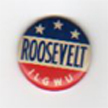First lady Eleanor Roosevelt was a larger-than-life figure, a well-known New Dealer with an affinity for the struggles of women, workers, and minorities. An adroit behind-the-scenes advocate, she also assumed a groundbreaking public role: she wrote a daily newspaper column, “My Day,” and joined the inchoate CIO Newspaper Guild in 1936.
She Was One of Us: Eleanor Roosevelt and the American Worker (Cornell University Press, 2010) chronicles Mrs. Roosevelt’s interaction with organized labor. This well-researched and clearly written book describes how women in New York taught Roosevelt about their working and living conditions and how over time she partnered with progressive labor leaders to advocate for a liberal policy agenda.
This is feminist historian Brigid O’Farrell’s sixth book. It fills an important gap in the literature—Mrs. Roosevelt’s relationship with the labor movement, which was extensive but little written about. O’Farrell is affiliated with the Eleanor Roosevelt Papers Project at George Washington University.
Eleanor Roosevelt’s interest in the plight of workers predated her marriage to Franklin and continued into the administration of John F. Kennedy, for whom she played a number of roles.
When she and Franklin were courting, she took her young suitor to visit a family in tenement housing, and he was shocked by the desperate living conditions. As first lady, she descended two miles underground to see firsthand the work life of coal miners. This was unprecedented for an upper-class woman and president’s wife.
Out of her experiences, Eleanor Roosevelt developed lifelong friendships with activists and labor leaders alike. She was particularly close to International Ladies’ Garment Workers’ Union (ILGWU) president David Dubinsky, and in the postwar years, to United Auto Workers president Walter Reuther.
Maida Springer was among the White House visitors with whom she stayed in contact. The garment-worker-turned-union-leader was born in Panama and was married to a man from Barbados. She was not the only Hispanic who identified as an African American in this era because of skin color.
Mrs. Roosevelt visited Puerto Rico in 1935. Her friend Rose Schneiderman, with the ILGWU and the Women’s Trade Union League, was on the island organizing garment workers. According to O’Farrell, Roosevelt “never forgot Puerto Rico” and worked on a number of projects there.
The book includes a number of references to Puerto Rican workers and their unions in New York; the community’s significance within the labor movement and within the city has grown over time along with its share of the population.
Farm labor was one of Roosevelt’s longtime interests. Actress (later, California representative) Helen Gahagan Douglas and her politically active husband, actor Melvyn Douglas, used their visits to the Roosevelt White House to bring the plight of California farm workers to the president and first lady.
Eleanor Roosevelt supported extending collective bargaining rights to agricultural workers and (along with Walter Reuther) urged AFL-CIO president George Meany to fund the Agricultural Workers Organizing Committee (AWOC) in the early sixties.
The book includes a great photo of the National Farm Labor Advisory Committee meeting in 1959. Mrs. Roosevelt is surrounded by Frank Graham, president of the University of North Carolina; A. Philip Randolph, African American president of the Sleeping Car Porters; former congresswoman Helen Gahagan Douglas; and Eisenhower’s secretary of labor, James Mitchell.
Unstated in the book—but important for readers to understand—is the role of the National Farm Labor Advisory Committee and AWOC in helping to create the political conditions for Kennedy to end the Bracero Program and the financial support from groups like the United Auto Workers and the AFL-CIO that made possible the later success of the United Farm Workers.
* * *
Go to O’Farrell’s page for more information on book signings.



